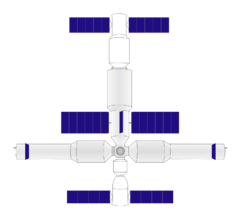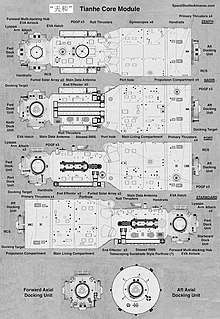Core Cabin Module
The Tianhe (Chinese: 天和; pinyin: Tiānhé; lit.: 'Unification of Heaven'), code name TH, or Core Cabin Module (CCM) is the foundation element of the Chinese space station, as the final stage of Project 921 Tiangong program, part of the Chinese space program.[3][5] The CCM follows the Salyut and Almaz series, Cosmos 557, Skylab, Mir, ISS, Tiangong 1 and Tiangong 2 space stations. It is the first part of a third generation modular space station. Other examples of modular station projects include the Soviet/Russian Mir, Russian OPSEK, and the International Space Station. Operations will be controlled from the Beijing Aerospace Command and Control Center in the People's Republic of China. In 2018 fullscale mockup of CCM was publicly presented at China International Aviation & Aerospace Exhibition in Zhuhai[6][7]
 | |
| Module statistics | |
|---|---|
| Part of | Chinese space station |
| Launch date | Planned: 2021[1] |
| Launch vehicle | LM-5B |
| Mass | 22 t (24 tons)[2][3][4][5] |
| Length | 18.1 m (59 ft) |
Functions and systems
The Core Module provides life support and living quarters for three crew members, and provides guidance, navigation, and orientation control for the station. The module also provides the station's power, propulsion, and life support systems. The module consists of three sections: the habitable living quarter, the nonhabitable service section, and a docking hub.[5]
The living quarters will contain a kitchen and toilet, fire control equipment, atmospheric processing and control equipment, computers, scientific apparatus, communications equipment to see and hear ground control in Beijing, and other equipment.[5] It will also have a small robotic arm, similar to the MIR Lyappa arm, to move the modules to different ports.[5]
Electrical power is provided by two steerable solar power arrays, which use photovoltaic cells to convert sunlight into electricity. Energy is stored to power the station when it passes into the Earth's shadow. Resupply ships will replenish fuel for the module's propulsion engines for station-keeping, to counter the effects of atmospheric drag.[8]
Structure

China has established "a good working relationship" with space agencies in Russia, France, Germany and other countries. With a long history of technology transfer with Russia, Chinese space assets are compatible with Russian orbital hardware. The MARS-500 collaborative study between China, Russia and Europe prepares for a deep space manned mission to Mars.
The forward docking hub allows the core module to be docked with four other space station visiting craft, including two experimental modules, a cargo ship Tianzhou spacecraft, and a Shenzhou spacecraft. The axial and nadir port of the module will be fitted with rendezvous equipment. A mechanical arm similar to the Russian Lyappa arm used on the Mir space station will be fitted to each of the future experiment modules. The axial port on the docking hub will be the primary docking port. When new modules arrive, they will first dock here, then the mechanical arm shall attach and move the module to a radial port. Crew and supply ships from the Jiuquan Satellite Launch Center will dock to either of the axial ports of the module, as well as the nadir (lower) port. The zenith (Space facing) port has been modified to act as the stations EVA hatch, as the spherical docking hub is also the EVA airlock.
The first space station, Salyut 1, and other one-piece or 'monolithic' first generation space stations, such as Salyut 2,3,4,5, DOS 2, Kosmos 557, Almaz and NASA's Skylab stations, were not designed for re-supply. Generally, each crew had to depart the station to free the only docking port for the next crew to arrive. Skylab had more than one docking port but was not designed for resupply. Salyut 6 and 7 had more than one docking port and were designed to be resupplied routinely during crewed operation. Modular stations can allow the mission to be changed over time, and new modules can be added or removed from the existing structure, allowing greater flexibility. The CCM is designed for replenishment of consumables and has a service life of at least 10 years.
The length of the module is 18.1m. It is cylindrical with a maximum diameter of 4.2m and an on orbit mass between 20 and 22 thousand kilograms.
Launch
It is expected to launch in 2021[1] on a Long March 5B from Wenchang Satellite Launch Center, into a Low Earth Orbit 340 to 450 km above the Earth at an orbital inclination of 42 to 43 degrees.[4]
See also
References
- Jones, Andrew (October 2, 2019). "This Is China's New Spacecraft to Take Astronauts to the Moon (Photos)". Space.com. Retrieved November 1, 2019.
- "China expects to complete space station by 2023". China Daily. September 25, 2013. Retrieved June 29, 2016.
- "中国载人航天工程标识及空间站、货运飞船名称正式公布" [CMSE logo and space station and cargo ship name officially announced] (in Chinese). CMSEO. October 31, 2013. Retrieved June 29, 2016.
- Ping, Wu (June 2016). "China Manned Space Programme: Its Achievements and Future Developments" (PDF). China Manned Space Agency. Retrieved June 28, 2016.
- Ping, Wu (April 23, 2016). "空间站工程研制进展" [Space Station Project Development Progress] (PDF). CMSEO. Archived from the original (PDF) on September 14, 2016. Retrieved June 29, 2016.
- "航天控制中心" [Aerospace Control Center] (in Chinese). China Manned Space Engineering. September 17, 2008. Retrieved June 29, 2016.
- "天和一号核心舱(TianHe-1)" [Tian He core module (TianHe-1)]. www.chinaspaceflight.com (in Chinese). June 7, 2016. Retrieved June 30, 2016.
- David, Leonard (March 7, 2011). "China Details Ambitious Space Station Goals". SPACE.com. Retrieved March 9, 2012.